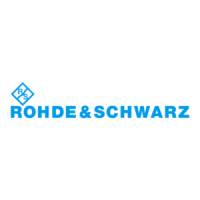GUI reference
R&S
®
ZNA
375User Manual 1178.6462.02 ─ 20
Properties: The stimulus variable appears on the horizontal axis, scaled linearly. The
magnitude of the complex quantity C, i.e. |C| = sqrt ( Re(C)
2
+ Im(C)
2
), appears on the
vertical axis, scaled in dB. The decibel conversion is calculated according to dB
Mag(C) = 20 * log(|C|) dB.
Application: dB Mag is the default format for the complex, dimensionless S-parame-
ters. The dB-scale is the natural scale for measurements related to power ratios (inser-
tion loss, gain etc.).
Tip (alternative formats): The magnitude of each complex quantity can be displayed
on a linear scale. It is possible to view the real and imaginary parts instead of the mag-
nitude and phase. Both the magnitude and phase are displayed in the polar diagram.
Remote command:
CALCulate<Chn>:FORMat MLOGarithmic
Phase
Selects a Cartesian diagram with a linear vertical axis to display the phase of a com-
plex measured quantity in the range between –180 degrees and +180 degrees.
Properties: The stimulus variable appears on the horizontal axis, scaled linearly. The
phase of the complex quantity C, i.e. φ (C) = arctan ( Im(C) / Re(C) ), appears on the
vertical axis. φ (C) is measured relative to the phase at the start of the sweep (refer-
ence phase = 0°). If φ (C) exceeds +180° the curve jumps by –360°; if it falls below –
180°, the trace jumps by +360°. The result is a trace with a typical sawtooth shape.
The alternative "Unwr Phase" format avoids this behavior.
Application: Phase measurements, e.g. phase distortion, deviation from linearity.
Tip (alternative formats): The magnitude of each complex quantity can be displayed
on a linear scale or on a logarithmic scale. It is possible to view the real and imaginary
parts instead of the magnitude and phase. Both the magnitude and phase are dis-
played in the polar diagram. As an alternative to direct phase measurements, the ana-
lyzer provides the derivative of the phase response for a frequency sweep (Delay).
Remote command:
CALCulate<Chn>:FORMat PHASe
Smith
Selects a Smith chart to display a complex quantity, primarily a reflection S-parameter.
Properties: The Smith chart is a circular diagram obtained by mapping the positive
complex semi-plane into a unit circle. Points with the same resistance are located on
circles, points with the same reactance produce arcs. If the measured quantity is a
complex reflection coefficient S
ii
, then the unit Smith chart represents the normalized
impedance. In contrast to the polar diagram, the scaling of the diagram is not linear.
Application: Reflection measurements; see example in "Smith" on page 116.
Tip: The axis for the sweep variable is lost in Smith charts but the marker functions
easily provide the stimulus value of any measurement point. dB values for the magni-
tude and other conversions can be obtained by the "Marker Format" functions.
Remote command:
CALCulate<Chn>:FORMat SMITh
Format softtool

